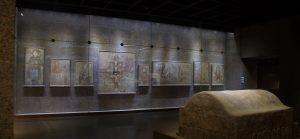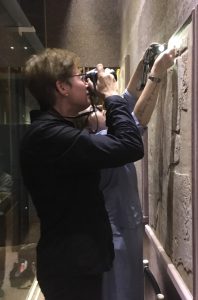Dobrochna and I travelled to Aswan to start our work at the Nubia Museum and plan our research visits to Dayr Anba Hadra, Philae, and the temples of Kalabsha and Wadi es-Sebua.
After a long procedure, we had permission to work in the Nubia Museum and storerooms in Aswan and the Coptic Museum in Cairo. Our aim was to study the wall paintings taken from the walls of the churches of Abu Oda, Wadi es-Sebua, Abdallah N’Irqi, and Tamit during the UNESCO International Campaign to save the monuments of Egypt and Nubia from the rising water of Lake Nasser/Nubia in the 1960s, as well as to take samples from the paint- and plaster layers.

Dayr Anba Hadra, the qasr

The painted ceiling of the so-called “Cave of Anba Hadra”, according to tradition the dwelling place of the saint
Firstly, we visited Dayr Anba Hadra, on the west bank of the Nile, opposite the island of Elephantine. Since 2013, an international team organized by the Freie Universität Berlin and the German Archaeological Institute in Cairo has been documenting and studying the inscriptions, wall paintings, and architecture of the monastery. Within this project, I worked on the documentation and study of the wall paintings, together with Alexandra Winkels, the restorer. Alexandra was at work and Ralph Bodenstein, the new project director, also took time to discuss all sorts of subjects related to the history of the monastery and the wall paintings.
In Aswan we were joined by Dr Ashraf Nageh of the Research and Preservation Centre of Antiquities of the Ministry of Antiquities in Cairo, who supervised the sampling and took the samples to Cairo for further processing. Adam joined us a few days later, after participating in a conference in Cairo at the Institut français d’archéologie orientale, co-organised by the Polish Centre for Mediterranean Archaeology – University of Warsaw.
The Nubia Museum was built by UNESCO to preserve and show the finds of the excavations carried out in the framework of the UNESCO International Campaign to save the monuments of Egypt and Nubia. The museum buildings are set in beautiful gardens and the complex has won prizes for its architecture. The director Dr Hosni Abd’el-Rahim Ibrahim welcomed us and he was very helpful in facilitating our work. Dr Ashraf and Mr Yasser Abd el Rady Mohamed (conservator of the museum) took samples of four paintings from Abdallah N’Irqi.

The Abdallah N’Irqi gallery in the museum

Dobrochna, Ashraf and Yasser at work

Gertrud and Dobrochna
Moreover, we visited the storeroom of the museum where Adam consulted several texts. The storerooms are clean and well arranged; to our surprise, the stone twin entrance of the church in the temple of Wadi es-Sebua is preserved here. When the temple was moved to higher ground in 1964, this entrance was removed. Its whereabouts were not known but all blocks, safe and numbered are in Aswan.
The museum has also a very well ordered (photo) archive on the removal and rebuilding of the temples under the UNESCO project. Unfortunately, we did not have enough time for consulting the archive.
Apart from Dr Hosni and Mr Yasser, we would like to thank Ms Fatma Awad el Said (conservator), and Mr Ahmed Abdel Rahman, Ms Naglaa Gharib Abdel Rahman, and Ms Shimaa Gomaa Saleh (curators).

The Temple of Kalabsha

Crosses and reliefs – the Christian paintings have disappeared
After Ashraf had returned to Cairo with the precious samples, we visited New Kalabsha, a peninsula to the south of Aswan where the temples of Kalabsha, Gerf Hussein and Beit el-Wali, as well as the Kiosk of Qertassi were relocated. The impressive Kalabsha Temple, built by the Emperor Augustus, once housed a church which was decorated with wall paintings. Almost all Christian features had disappeared at the beginning of the 20th century when the temple was restored.

Adam – on our way to Philae
We went to Philae afterwards, where traces of a church have been preserved in the Great Temple of Isis. The boat trips on the lake to reach these monuments were as memorable as the visits.

Column in the Isis Temple
The next day, with inspector Mr Ahmed Hassan Abdel Majid, we visited New Wadi es-Sebua, the place where the temples of Wadi es-Sebua, Maharaqqa and Dakka have been relocated. And finally, we stood eye to eye with Saint Peter and the adoring Ramesses. Unfortunately, the painting of Saint Peter has suffered much during the years. It was a remarkable day: the desert, the silence, the lake and the temples, and no other visitors (only when we left a group did arrive).

The Temple of Wadi es-Seboua


The night train took us to Cairo where we stayed at the Polish Centre in Heliopolis. Our main task in Cairo was work on the wall paintings in the storeroom of the Coptic Museum. After a few days, Adam left for Warsaw and Dr. Olga Syta, our chemist, arrived. She would work with Ashraf and his colleagues on the analysis of the samples.

The Coptic Museum in Old Cairo was founded by Marcus Simaika Pasha in 1908. It is partly built on the remains of the Roman fortress Babylon, and the entrance gate is situated next to one of the fortress towers. We were welcomed by Ms Jehan Atef Shoukhi, director and vice-director Mr Hany Zarif Khalil. After some delay, we were able to start. Since the storeroom is quite small, paintings were taken outside for photography and sampling, under the supervision of Ashraf.

Marleen, Ms Safaa, Olga, and Mr Mina

Olga at work
We thank Ms Jehan for her help and hospitality, and we thank Mr Hany, Ms Safaa Helmi Abdellatif (curator of wall paintings), Mr Mina Asad Selim Acladeus (conservator), Ms Marleen Farag, Ms Randa Fayek, Ms Hadeer Belal, Mr Emed Bekhit (curators) and Ms Irini Sarkis (conservation department).
The photographic collection of the Scientific Archive Department at the Centre of Documentation and Studies of Ancient Egypt of the Ministry Of Antiquities in Zamalek was our last stop. Dr Hisham el-Leithy, director of the Documentation Centre and his staff were very helpful but we have to go back – we didn’t have enough time for this extremely rich collection of photographs that documents the Nubian temples and the dismantling and the rebuilding of the monuments at a higher location during the UNESCO programme.

In the meantime, tests were being done at the laboratory with Olga assisting the staff of the Research and Preservation Centre.
It was a very successful trip – we were able to sort out research questions, fill in details, collect samples for analysis, and discuss our investigations with old and new colleagues and friends. The support and efficiency of directors and staff members of the various museums and institutions were greatly appreciated. Special thanks go to Dr Ashraf Nageh!
And back in Warsaw it was very cold…
